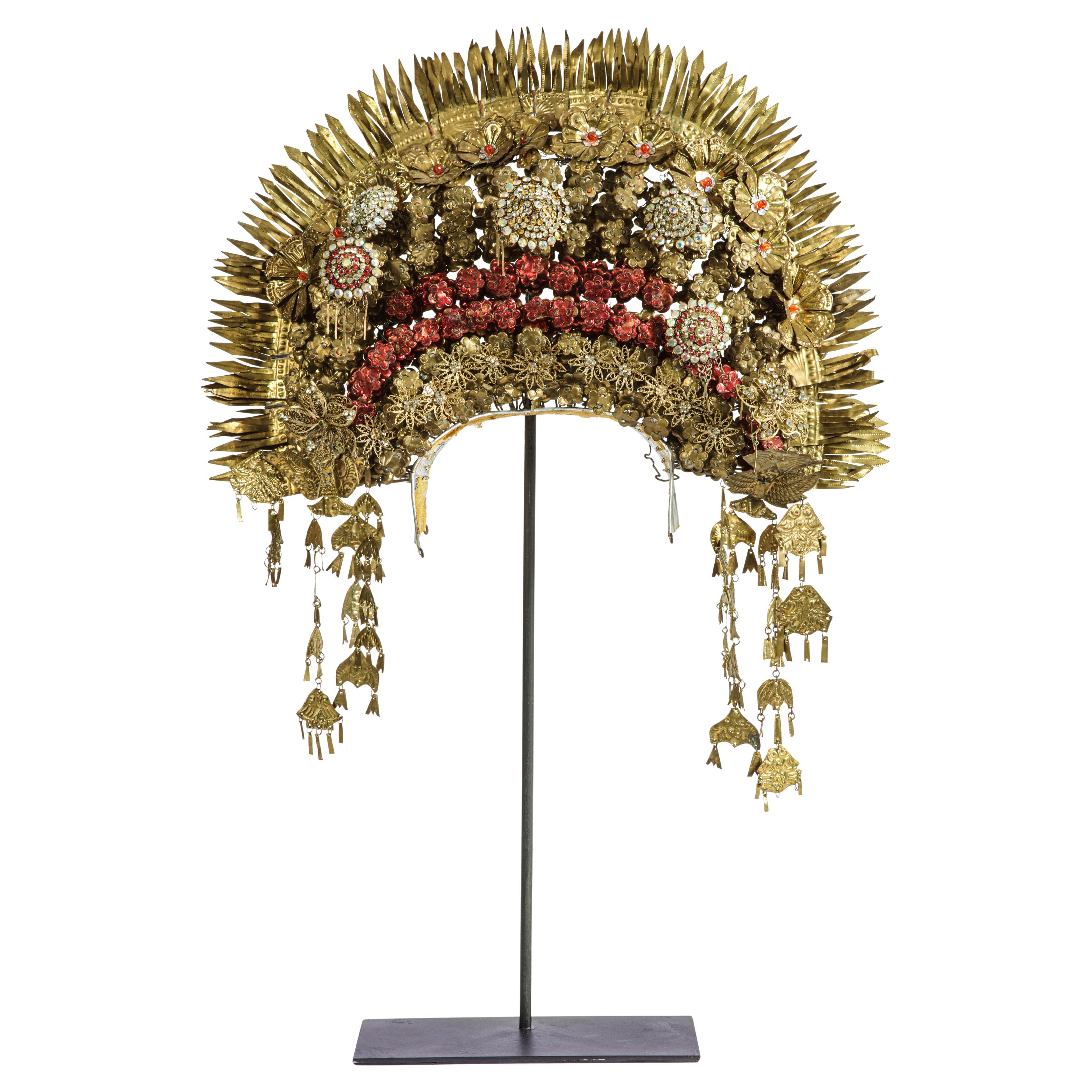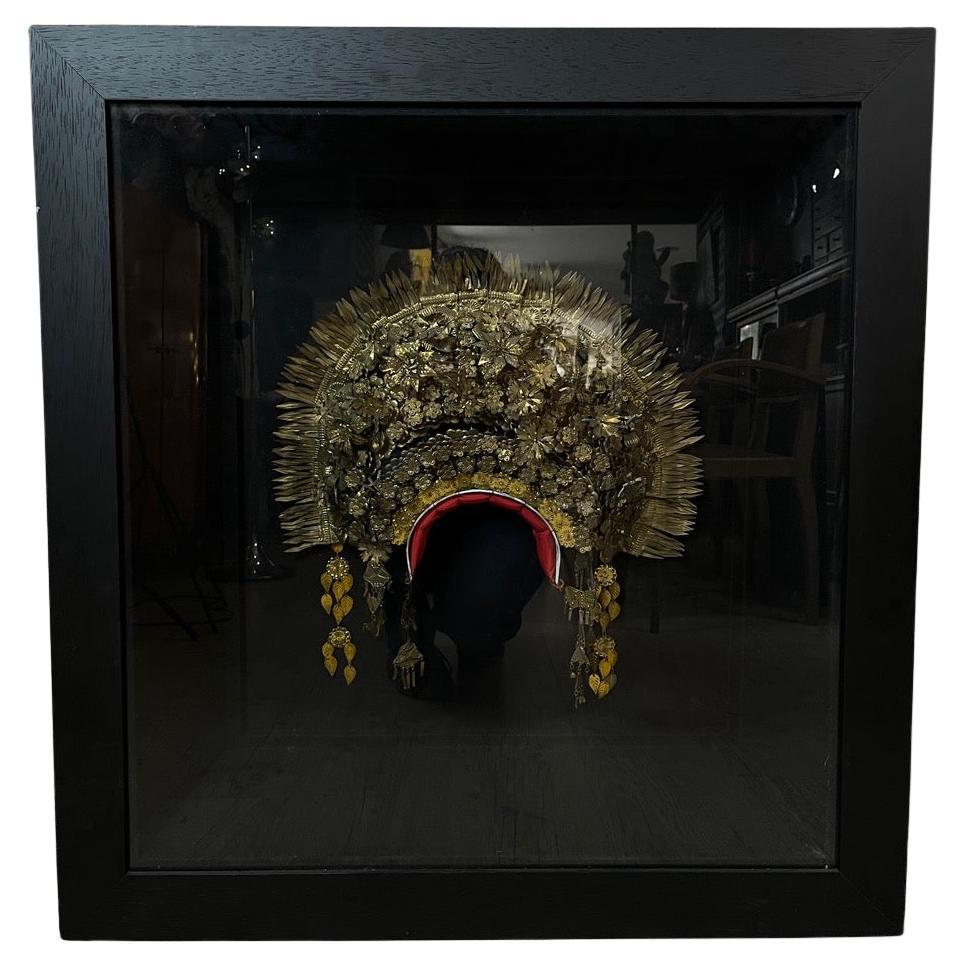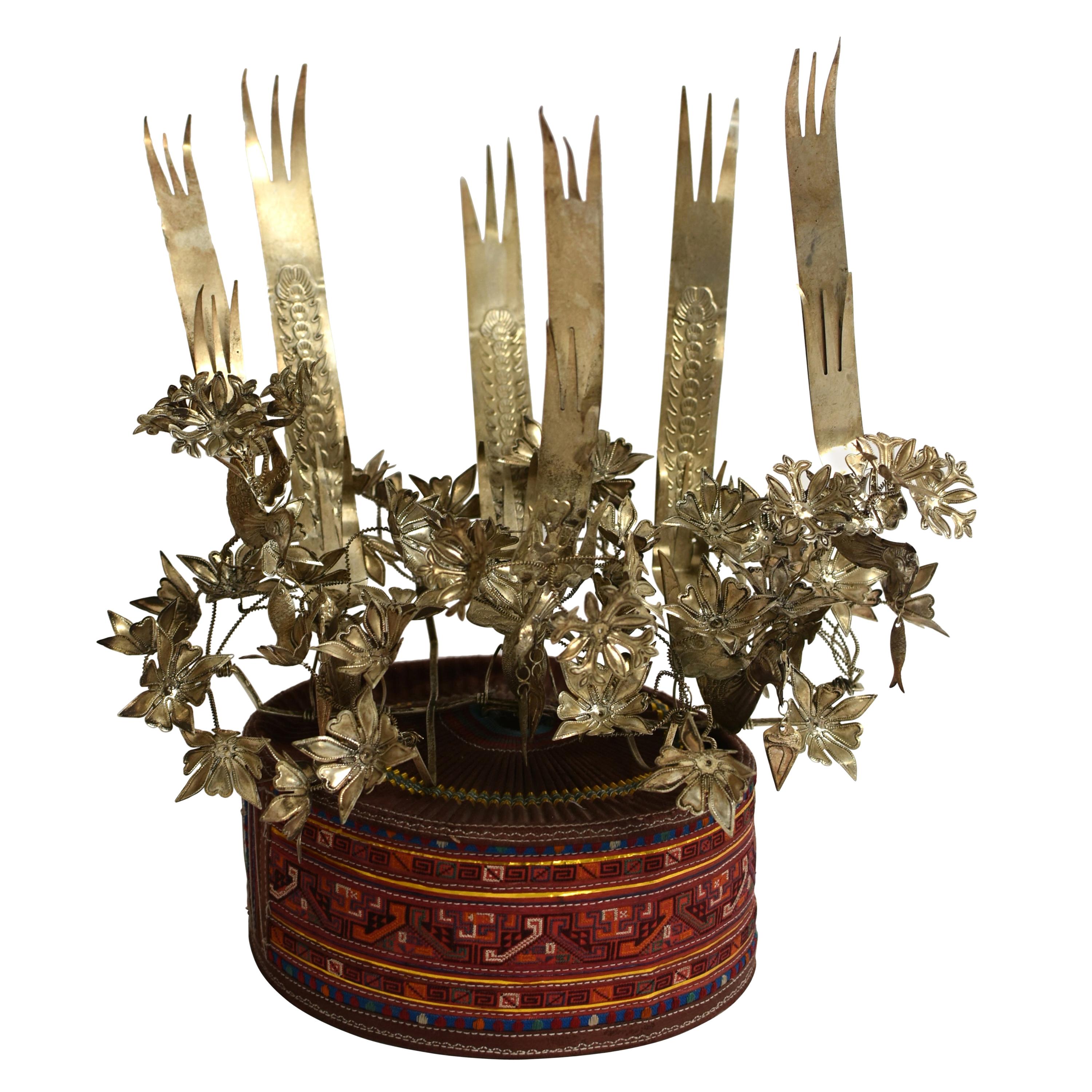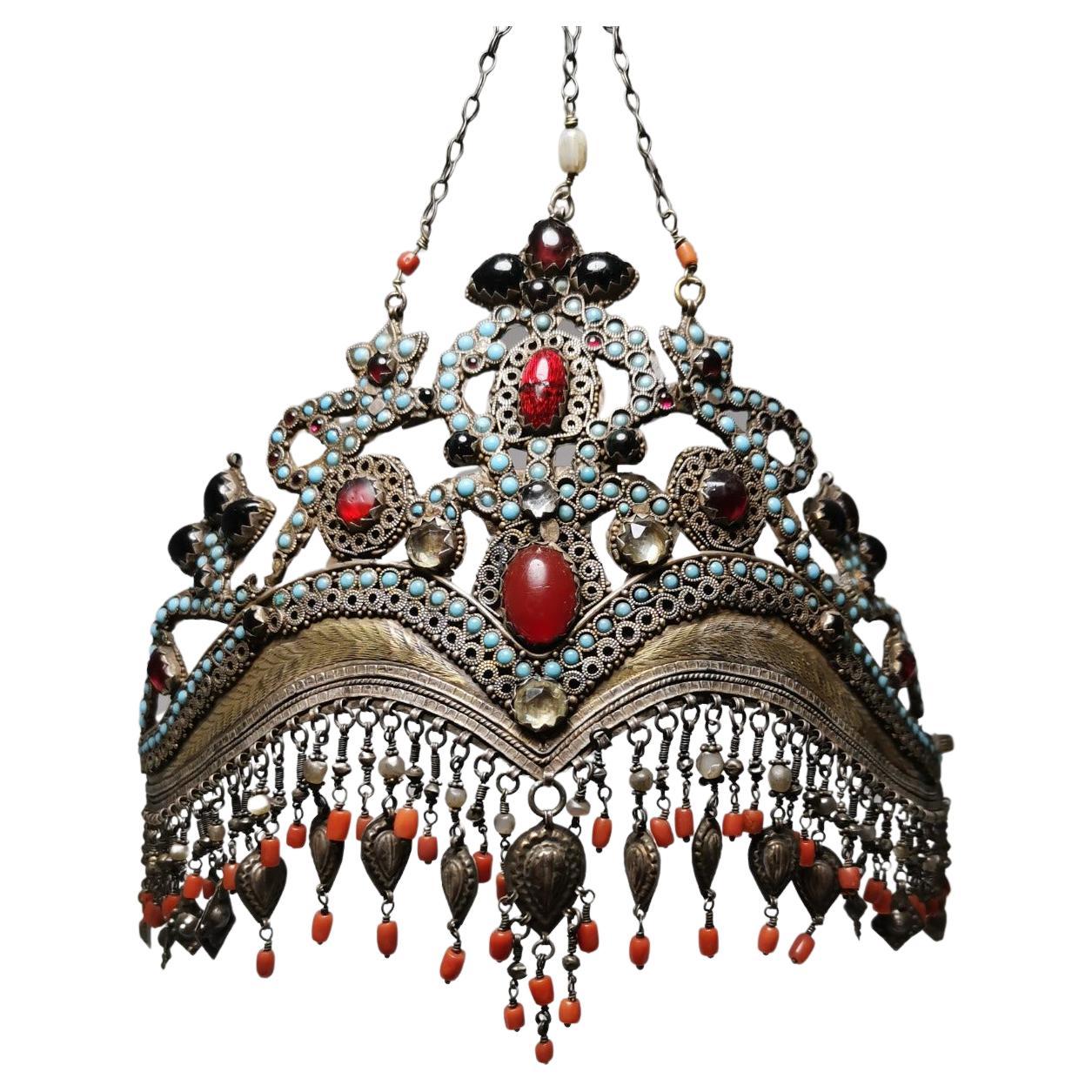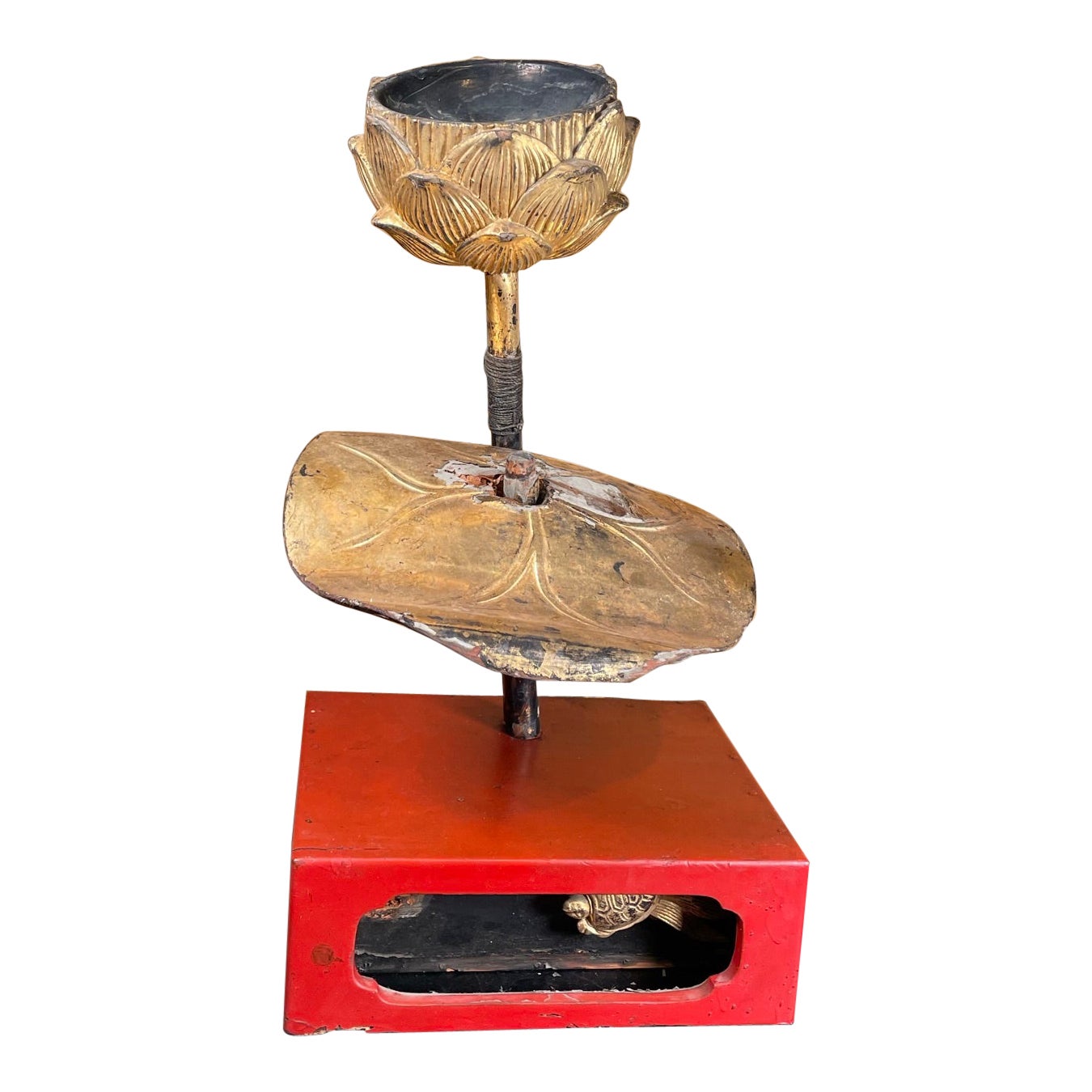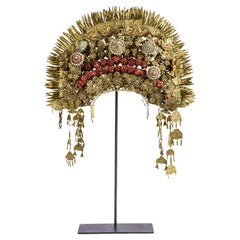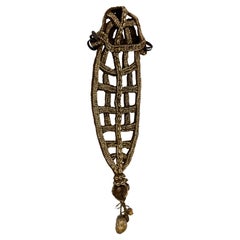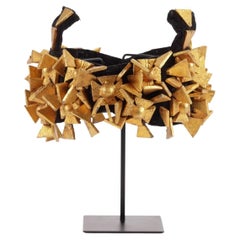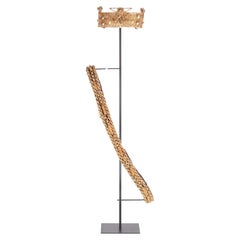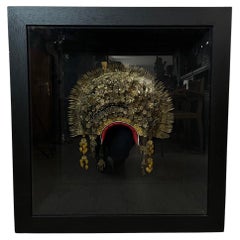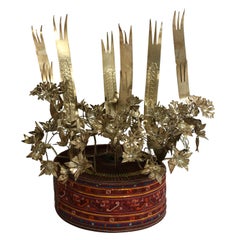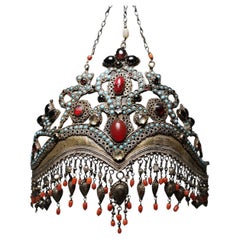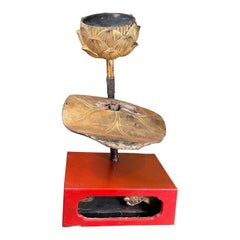Items Similar to A superb Minangkabau red-enamelled and brass wedding crown or 'Suntiang'
Want more images or videos?
Request additional images or videos from the seller
1 of 4
A superb Minangkabau red-enamelled and brass wedding crown or 'Suntiang'
$3,413.56
£2,529.63
€2,850
CA$4,660.16
A$5,184.23
CHF 2,717.64
MX$63,350.06
NOK 34,605.75
SEK 32,576.53
DKK 21,699.65
Shipping
Retrieving quote...The 1stDibs Promise:
Authenticity Guarantee,
Money-Back Guarantee,
24-Hour Cancellation
About the Item
A Minangkabau red-enamelled and brass wedding crown or 'Suntiang'
A Minangkabau red-enamelled and brass wedding crown or 'Suntiang'West Sumatra, Minangkabau, probably 1st half 20th century
H. 47.4 cm (incl. stand)
Provenance:
Private collection, the Netherlands
The Suntiang: Crowning the bride
In the Minangkabau culture, wedding crowns hold great cultural significance and symbolism. The Minangkabau people in West Sumatra, Indonesia, are well recognised for their very unique matrilineal social structure and abundant cultural heritage. One of their most visually captivating traditions is the usage of intricate bridal crowns, referred to as suntiang, worn by brides throughout traditional wedding rituals. The suntiang serves as more than a mere decorative head embellishment; it represents cultural heritage, societal principles, and the esteemed status of women in Minangkabau culture.
Design
The suntiang is an imposing headpiece, usually made from several layers of gold-plated metal or imitation gold, adorned with floral patterns, mainly chrysanthemum forms, carefully distributed throughout the tiers. Based on the social standing of the bride and the specific style of the location, a suntiang can vary in thickness from 3 to 11 layers, with certain intricate variations extending to 20 layers. The weight of the crown, which may surpass several kilogrammes, serves as an indicator of status and endurance, representing the fortitude and tenacity anticipated from the bride.
The design of the suntiang is profoundly emblematic. According to tradition, the floral decorations orientated upwards symbolise purity, fertility, and prosperity. The predominant material, gold, represents not just affluence but also divine protection and spiritual purity, said to shield the bride from adverse influences. Each stratum of the crown contributes additional levels of significance, as higher tiers symbolise more sagacity and obligations as the bride assumes her duties as a spouse and parent.
Social and cultural meaning
Within the Minangkabau culture, characterised by a pronounced matrilineal structure, women have a crucial role in preserving the family's lineage and customs. The suntiang functions as a potent visual manifestation of this function, underscoring the significance of women in the society. The crown symbolises the profound concepts of reverence, dignity, and accountability that are firmly embedded in Minangkabau culture.
By donning the suntiang at the wedding ceremony, the bride demonstrates her preparedness to assume her new obligations, while simultaneously highlighting the family's sense of pride and commitment to customs. The weight of the crown, commonly perceived as a load, symbolises the responsibilities that the bride would bear in her married life, emphasising the need of perseverance and fortitude in carrying out these tasks appropriately.
Regional variations
Although the suntiang is well acknowledged throughout the Minangkabau region, its style and design can differ greatly based on the local customs. Crowns in coastal regions often exhibit a greater degree of fragility and complexity, which can be attributed to the impact of commerce and foreign cultural exchanges. Conversely, the highland areas display a preference for more sturdy and intricate patterns, frequently including supplementary decorations and hues that symbolise the local culture.
Within modern Minangkabau culture, there have been modifications made to the traditional suntiang. Contemporary brides may choose for lighter fabrics, which afford them enhanced comfort without compromising the magnificence and importance of the original design. Nevertheless, despite these modifications, the suntiang continues to be an essential element of Minangkabau identity, preserving its function as a representation of the ongoing continuity between historical customs and current rituals.
- Dimensions:Height: 18.67 in (47.4 cm)Width: 13.78 in (35 cm)Depth: 5.91 in (15 cm)
- Materials and Techniques:
- Place of Origin:
- Period:
- Date of Manufacture:20th century
- Condition:Wear consistent with age and use.
- Seller Location:Amsterdam, NL
- Reference Number:1stDibs: LU5458241340982
About the Seller
5.0
Recognized Seller
These prestigious sellers are industry leaders and represent the highest echelon for item quality and design.
Established in 1985
1stDibs seller since 2020
23 sales on 1stDibs
Typical response time: 2 hours
- ShippingRetrieving quote...Shipping from: Amsterdam, Netherlands
- Return Policy
Authenticity Guarantee
In the unlikely event there’s an issue with an item’s authenticity, contact us within 1 year for a full refund. DetailsMoney-Back Guarantee
If your item is not as described, is damaged in transit, or does not arrive, contact us within 7 days for a full refund. Details24-Hour Cancellation
You have a 24-hour grace period in which to reconsider your purchase, with no questions asked.Vetted Professional Sellers
Our world-class sellers must adhere to strict standards for service and quality, maintaining the integrity of our listings.Price-Match Guarantee
If you find that a seller listed the same item for a lower price elsewhere, we’ll match it.Trusted Global Delivery
Our best-in-class carrier network provides specialized shipping options worldwide, including custom delivery.More From This Seller
View AllAn elaborate Minangkabau gem-set brass floral wedding crown or 'Suntiang'
Located in Amsterdam, NL
An elaborate Minangkabau gem-set brass floral wedding crown or 'Suntiang'
West Sumatra, Minangkabau, probably 1st half 20th century
H. 66.5 cm (incl. stand)
Provenance: Private co...
Category
Mid-20th Century Indonesian Metalwork
Materials
Brass, Enamel
A bridal headdress from Papua called 'ambusap'
Located in Amsterdam, NL
Iatmul, Papua New Guinea, 20th century
This ceremonial headdress is traditionally worn by a young bride as she enters her new husband’s home for the first time. Adorned with shells—...
Category
Antique 19th Century Papua New Guinean Tribal Art
Materials
Shell, Natural Fiber
Traditional Ashanti African Chief’s velvet and gilt-wood Leopard crown on stand
Located in Amsterdam, NL
A traditional Ashanti Chief’s velvet and giltwood Leopard crown
Ghana, early 20th century
Diam. 17 cm (crown)
H. 27 cm (incl. stand)
Provenance:
Pri...
Category
Early 20th Century Ghanaian Antiquities
Materials
Velvet, Giltwood
Ashanti African Chief’s ceremonial gold and gilt-metal crown and sash on stand
Located in Amsterdam, NL
An Ashanti Chief’s ceremonial gold and gilt-metal crown and sash
Ghana, early 20th century
Diam. 20 cm (crown)
L. 128 cm (sash)
H. 102 cm (incl. st...
Category
Early 20th Century Ghanaian Art Nouveau Tribal Art
Materials
Gold, Gold Plate, Metallic Thread
A colourful beaded Yoruba 'crown'
Located in Amsterdam, NL
Yoruba People, Nigeria, 20th century
Provenance:
- Collection Rinck Hollnberger, Munich (purchased in the 1980s or 1990s)
Category
20th Century Nigerian Tribal Art
Materials
Beads
A Huli wigman's ceremonial headdress
Located in Amsterdam, NL
Papua New Guinea, Central Highlands, Huli people, 1st half 20th century
Crafted from the wearer’s own hair and adorned with colorful bird-of-paradise feathers, flowers, scarab beetl...
Category
20th Century Papua New Guinean Tribal Art
Materials
Shell, Feathers
You May Also Like
19th century Balinese Brass Wedding Headdress Framed, 1890s
Located in LEGNY, FR
Elevate your interior with this unique and authentic art piece from the 19th century : a traditional Balinese brass wedding headdress, carefully presented in an elegant frame.
A true...
Category
Antique 19th Century Balinese Sculptures and Carvings
Materials
Brass
Vintage Chinese Miao Tribe Hat with 6 Silvered Birds and 40 Flowers
Located in Somis, CA
A beautiful hand made Miao tribe hat with silvered metal ornaments. The hand made hat is covered with embroidered bands. The prominent crown is decorated with 6 hand made phoenixes, ...
Category
Late 20th Century Chinese Metalwork
Materials
Metal
$275 Sale Price
58% Off
Uzbekistan, Tajikistan: a Rare, Old ‘Bridal Crown’ 20th Century
Located in Madrid, ES
Uzbekistan, Tajikistan: a rare, old ‘bridal crown’ made of silver, gilded in parts, with turquoise coloured ornamental stones, glass, coral, and many pend...
Category
20th Century Uzbek Modern Antiquities
Materials
Silver
Japanese Fine Antique Gilt and Red Lacquer Lotus Bud Flower, Edo Period 19th C
Located in South Burlington, VT
From our recent Japanese acquisitions, a rare find
Antique Original Japanese temple "blossoming lotus" flower bud stem including its original red lacquer display base. This finely hand carved wood and lacquered gold flower stem was made for a Buddhist 19th century temple altar. Its flower blossoms and leaves symbolize the stages of the path toward enlightenment. The individual parts of each lotus is carved separately then joined in an arrangement and inserted in altar vessels.
Also called "Jyôka" , it is placed on or next to an altar in a Buddhist temple. Made with meticulous techniques. In Buddhism, the lotus is an important symbol of divine enlightenment because it blooms into beautiful flowers while growing in mud. Tsunehana means "a flower that continues to bloom forever" and "a flower that does not wither." For this reason, the flowers represented are in different stages of their life, unfolded lotus leaves, buds and full flowers, thus symbolizing the journey towards Buddhist enlightenment.
This lovely Japanese antique gilt Lotus flower is an early survivor, circa 1840, and a hard to find treasure that was originally placed on or around a temple altar.
This ensemble consists of a single stem, the top most flower, and the bottom leaf- all mounted in the original square red lacquer display base. A gold gilt 3.5 inch long tortoise "minogame" is affixed to the base as seen in the photo.
Its attractive original old patina coupled with much of the original gilding remaining present is just the way we like to find them.
Dimensions: With original red lacquer display stand Height, 17 inches height and 9 inches in width. The lotus flower stem alone measures 16 inches in height.
Provenance: acquired from a Kyoto Japanse monk and collector
History of the Japanese turtle "minogame"
One of the most famous is the mythological giant turtle...
Category
Antique 1840s Japanese Edo Sculptures and Carvings
Materials
Wood
Chinese Silver & Leather Theatre Opera / Wedding Tiered Phoenix Headdress, 1920s
Located in West Palm Beach, FL
Chinese Silver & Leather Theatre Opera / Wedding Tiered Phoenix Headdress, 1920s
Silvered Metal & leather and embroidered Mandarin hat
This Chinese silv...
Category
Early 20th Century Chinese Chinese Export Historical Memorabilia
Materials
Metal
$3,080 Sale Price
20% Off
Pair of Antique Japanese Buddhist Temple Headdress and Necklace Ornaments
Located in Hudson, NY
Pair of antique Japanese Buddhist temple headdress and necklace ornaments. Gilt bronze with decorative stones and beads, and intricate metalw...
Category
Antique Early 19th Century Japanese Edo Metalwork
Materials
Bronze
More Ways To Browse
Brass Crown
Vintage Bride
Red Vintage Floral Fabric
Brass Lighter Vintage
Enamel Lighter
Converse Vintage
Indonesian Brass
3 Tier Stand
Bridal Crown
Chrysanthemum Plate
Tiered Plate Stand
Indonesian Wedding
3 Tier Stand Vintage
Vintage 3 Tiered Stand
Vintage Tiered Plate Stand
Gold Crown Headpiece
Cloisonne Incense Burner
Cloisonne Marks Chinese
